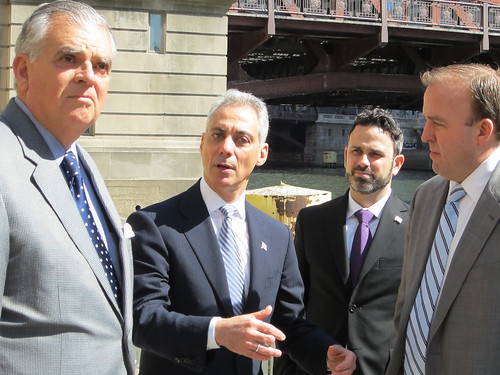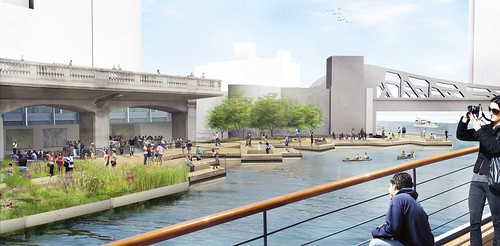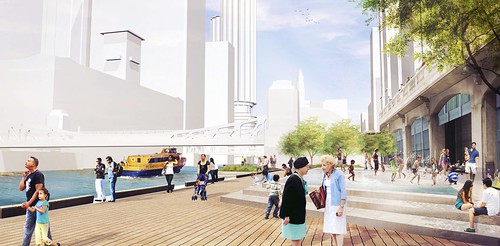At a waterside press conference this afternoon with Mayor Rahm Emanuel, outgoing U.S. Transportation Secretary Ray LaHood promised that the roughly $100 million federal loan that will bankroll the Chicago Riverwalk will definitely be finalized by June. Earlier this winter the Chicago Department of Transportation sent LaHood’s agency a letter of interest for a loan through the Transportation Infrastructure Finance Innovation Act. Now the USDOT is inviting CDOT to submit a formal application for the loan, which will cover almost the entire project cost.
This new segment of riverwalk would stretch from State to Lake Streets along the south bank of the waterway, incorporating six different themed sections delineated by the river bridges. The different areas would range from “The Jetty” fishing area to “The Cove” kayak dock to “The Swimming Hole” water play zone. The riverwalk would also serve as a car-free pedestrian commuting route for Loop workers and residents. Assuming the loan is approved, construction will start in 2014 and should be completed in two years, according to CDOT.
The riverwalk is the first project to get this far in the approval process since Congress expanded the loan program last year. “This is a big deal for us at the DOT because it really launches the TIFIA program,” LaHood said at the event. “It sends a message to mayors across the country: if you’ve got big dreams come to us.” He described the riverwalk as, “a big, bold project, just the kind of project we like at the DOT,” adding that new boat rental and tour locations, plus waterside restaurants and bars, will create a new economic corridor for small businesses and help create jobs.
LaHood said that the financing behind Chicago’s proposal is sound. “We’ve had outside financial people look at it to make sure the numbers add up.” The city plans to pay back the loan in approximately 35 years, with about 75 percent of revenue coming from tour boat and retail fees, according to CDOT Commissioner Gabe Klein. He said some of the remaining money may come from riverside advertising but promised it would be “very tasteful and very limited.”
At the press conference Emanuel said that by creating new recreational and retail opportunities along Chicago’s underutilized waterway, “We’re reintroducing the river to the city, and the city to the river.” He estimated that the construction of the riverwalk will create about 400 short-term jobs, while the new recreational and entertainment facilities will provide permanent employment for another 400 workers.
The mayor added that the riverwalk is one of five marquee public space initiatives in the works, along with the Bloomingdale, Maggie Daley Park, the redevelopment of Northerly Island, and the West Ridge Nature Preserve, next to Rosehill Cemetery. The five projects add up to about 125 acres, roughly five times the area of Millennium Park. “I told Ray that I wanted to make the Chicago River the next recreational frontier,” Emanuel said.
Klein touted the riverwalk as an addition to the city’s sustainable transportation network, breaking down the barriers between Wacker Drive and the waterway. The pedestrian walkway will help connect people to water taxis, bike-share kiosks, buses and trains, as well as recreational boating, he said. “This will be a transformative project for Chicago.”








